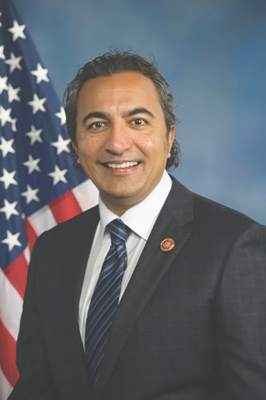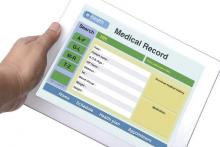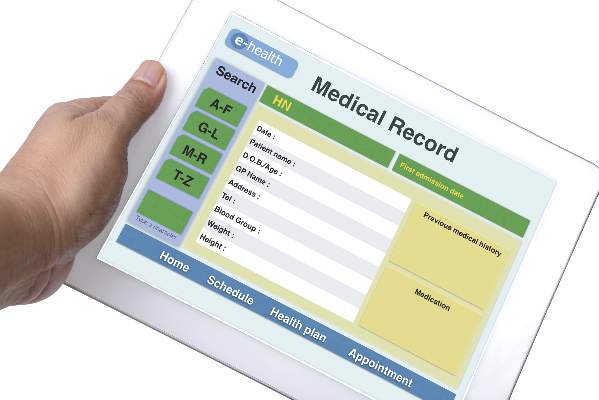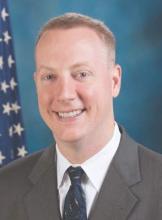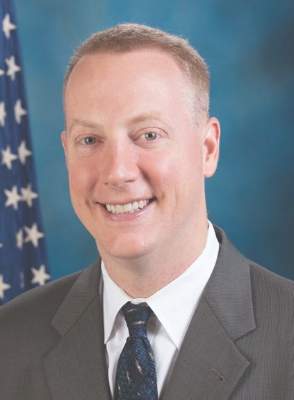User login
One internist to another: Rep. Bera says get involved in policy efforts
WASHINGTON – Doctors need to be more active in advocating for public policy, Rep. Ami Bera (D-Calif.) said at the annual meeting of the American College of Physicians.
“In medicine, this next decade is going to be transformative,” Rep. Bera, who is an internist, said May 5 during the opening general session. The foundation for enormous change was laid 6 years ago with the Affordable Care Act and refined last year with the Medicare Access and CHIP Reauthorization Act (MACRA). “This next decade will be how we implement and move forward.”
Rep. Bera called on his fellow physicians to play a larger role in shaping the policies.
“We are all busy taking care of our patients,” he said. “We are all busy practicing and teaching the next generation of physicians. But in truth, if we are not engaged with the policy makers, we don’t have a seat at the table.”
In particular, he noted that the focus of the conversation needs to be on keeping the patient at the center of policy changes going forward.
“Certainly while you are in Washington, D.C., you [should] try to stop by and visit your member of Congress,” he recommended. “But when you are back home in your districts, make sure that you are telling [your elected representatives] the stories of your patients, of what happens in the exam room or at the bed side or in the classroom. These are real issues that over the next decade we are going to have to grapple with.”
He said that while there are a lot of bright minds on Capitol Hill who are looking to move the country forward, “unless we bring our patients into that policy, the best policy may not always translate into practice, so that’s where those of us who have a unique perspective have to be part of the discussion.”
WASHINGTON – Doctors need to be more active in advocating for public policy, Rep. Ami Bera (D-Calif.) said at the annual meeting of the American College of Physicians.
“In medicine, this next decade is going to be transformative,” Rep. Bera, who is an internist, said May 5 during the opening general session. The foundation for enormous change was laid 6 years ago with the Affordable Care Act and refined last year with the Medicare Access and CHIP Reauthorization Act (MACRA). “This next decade will be how we implement and move forward.”
Rep. Bera called on his fellow physicians to play a larger role in shaping the policies.
“We are all busy taking care of our patients,” he said. “We are all busy practicing and teaching the next generation of physicians. But in truth, if we are not engaged with the policy makers, we don’t have a seat at the table.”
In particular, he noted that the focus of the conversation needs to be on keeping the patient at the center of policy changes going forward.
“Certainly while you are in Washington, D.C., you [should] try to stop by and visit your member of Congress,” he recommended. “But when you are back home in your districts, make sure that you are telling [your elected representatives] the stories of your patients, of what happens in the exam room or at the bed side or in the classroom. These are real issues that over the next decade we are going to have to grapple with.”
He said that while there are a lot of bright minds on Capitol Hill who are looking to move the country forward, “unless we bring our patients into that policy, the best policy may not always translate into practice, so that’s where those of us who have a unique perspective have to be part of the discussion.”
WASHINGTON – Doctors need to be more active in advocating for public policy, Rep. Ami Bera (D-Calif.) said at the annual meeting of the American College of Physicians.
“In medicine, this next decade is going to be transformative,” Rep. Bera, who is an internist, said May 5 during the opening general session. The foundation for enormous change was laid 6 years ago with the Affordable Care Act and refined last year with the Medicare Access and CHIP Reauthorization Act (MACRA). “This next decade will be how we implement and move forward.”
Rep. Bera called on his fellow physicians to play a larger role in shaping the policies.
“We are all busy taking care of our patients,” he said. “We are all busy practicing and teaching the next generation of physicians. But in truth, if we are not engaged with the policy makers, we don’t have a seat at the table.”
In particular, he noted that the focus of the conversation needs to be on keeping the patient at the center of policy changes going forward.
“Certainly while you are in Washington, D.C., you [should] try to stop by and visit your member of Congress,” he recommended. “But when you are back home in your districts, make sure that you are telling [your elected representatives] the stories of your patients, of what happens in the exam room or at the bed side or in the classroom. These are real issues that over the next decade we are going to have to grapple with.”
He said that while there are a lot of bright minds on Capitol Hill who are looking to move the country forward, “unless we bring our patients into that policy, the best policy may not always translate into practice, so that’s where those of us who have a unique perspective have to be part of the discussion.”
AT ACP INTERNAL MEDICINE 2016
Immunization improves with bidirectional data exchange between EHRs and registries
The implementation of bidirectional information sharing between electronic health records (EHRs) and immunization registries resulted in improved pediatric immunization coverage, according to new research in Pediatrics.
Researchers analyzed data from five practices providing pediatric primary care in the New York–Presbyterian Hospital Ambulatory Care Network 6 months before and after a 2009 implementation of a function that allowed for data from the N.Y. Citywide Immunization Registry to be downloaded directly to local practice site EHRs. Prior to that, data could only be uploaded from EHRs, and pediatricians would need to consult the registry separately to check immunization records.
Researchers found that after the implementation of bidirectional information sharing, “significant improvements in pediatric immunization coverage, a reduction in overimmunization for adolescents, and increased completeness of immunization records were observed,” Dr. Melissa S. Stockwell, professor at Columbia University, New York, and her colleagues, wrote in an article appearing online May 5 and scheduled for publication in the June 6 issue of Pediatrics (doi: 10.1542/peds.2015-4335).
According to the research, up-to-date status increased from 75% before to 81.6% after implementation for more than 6,000 children during each period. The percentage of overimmunized decreased from 8.8% to 4.7%.
Researchers suggested that the reason for the improvement was that doctors could make more informed decisions immediately about immunization rather than having to wait for family members to return for a later visit with paper immunization records.
“With full immunization data available electronically at point of care, clinicians may have felt more certain that they had accurate, complete immunization data and that the child was indeed missing the immunization,” Dr. Stockwell and her colleagues wrote. “It has been shown that children of parents who lack paper records are more likely to be underimmunized.”
The researchers reported no conflicts of interest. The study was supported by the Agency for Healthcare Research and Quality.
While meaningful use regulation requires that EHRs only feed information to immunization registries, more should be done by them to help retrieve information from them.
“I would love for the EHR vendors to address this issue and establish bidirectional communication with local/regional immunization registries to help with decision-making at the point of care,” Dr. J. Howard Smart said in an interview.
He also noted other challenges. Registries do not share data across state lines and even within states, such as California, regional registries are not sharing information.
“So even if someone comes from Los Angeles, we are not going to have immunization registry data for them.”
That being said, even if it were just bidirectional information on a local level, it would be a great asset to the practicing pediatrician.
“We are worried about both kinds of errors [missing scheduled vaccinations or overvaccinating], and having bidirectional information would really help that confidence.”
Dr. Smart is chief of pediatrics at Sharp Mary Birch Hospital for Women and Newborns in San Diego, Calif.
While meaningful use regulation requires that EHRs only feed information to immunization registries, more should be done by them to help retrieve information from them.
“I would love for the EHR vendors to address this issue and establish bidirectional communication with local/regional immunization registries to help with decision-making at the point of care,” Dr. J. Howard Smart said in an interview.
He also noted other challenges. Registries do not share data across state lines and even within states, such as California, regional registries are not sharing information.
“So even if someone comes from Los Angeles, we are not going to have immunization registry data for them.”
That being said, even if it were just bidirectional information on a local level, it would be a great asset to the practicing pediatrician.
“We are worried about both kinds of errors [missing scheduled vaccinations or overvaccinating], and having bidirectional information would really help that confidence.”
Dr. Smart is chief of pediatrics at Sharp Mary Birch Hospital for Women and Newborns in San Diego, Calif.
While meaningful use regulation requires that EHRs only feed information to immunization registries, more should be done by them to help retrieve information from them.
“I would love for the EHR vendors to address this issue and establish bidirectional communication with local/regional immunization registries to help with decision-making at the point of care,” Dr. J. Howard Smart said in an interview.
He also noted other challenges. Registries do not share data across state lines and even within states, such as California, regional registries are not sharing information.
“So even if someone comes from Los Angeles, we are not going to have immunization registry data for them.”
That being said, even if it were just bidirectional information on a local level, it would be a great asset to the practicing pediatrician.
“We are worried about both kinds of errors [missing scheduled vaccinations or overvaccinating], and having bidirectional information would really help that confidence.”
Dr. Smart is chief of pediatrics at Sharp Mary Birch Hospital for Women and Newborns in San Diego, Calif.
The implementation of bidirectional information sharing between electronic health records (EHRs) and immunization registries resulted in improved pediatric immunization coverage, according to new research in Pediatrics.
Researchers analyzed data from five practices providing pediatric primary care in the New York–Presbyterian Hospital Ambulatory Care Network 6 months before and after a 2009 implementation of a function that allowed for data from the N.Y. Citywide Immunization Registry to be downloaded directly to local practice site EHRs. Prior to that, data could only be uploaded from EHRs, and pediatricians would need to consult the registry separately to check immunization records.
Researchers found that after the implementation of bidirectional information sharing, “significant improvements in pediatric immunization coverage, a reduction in overimmunization for adolescents, and increased completeness of immunization records were observed,” Dr. Melissa S. Stockwell, professor at Columbia University, New York, and her colleagues, wrote in an article appearing online May 5 and scheduled for publication in the June 6 issue of Pediatrics (doi: 10.1542/peds.2015-4335).
According to the research, up-to-date status increased from 75% before to 81.6% after implementation for more than 6,000 children during each period. The percentage of overimmunized decreased from 8.8% to 4.7%.
Researchers suggested that the reason for the improvement was that doctors could make more informed decisions immediately about immunization rather than having to wait for family members to return for a later visit with paper immunization records.
“With full immunization data available electronically at point of care, clinicians may have felt more certain that they had accurate, complete immunization data and that the child was indeed missing the immunization,” Dr. Stockwell and her colleagues wrote. “It has been shown that children of parents who lack paper records are more likely to be underimmunized.”
The researchers reported no conflicts of interest. The study was supported by the Agency for Healthcare Research and Quality.
The implementation of bidirectional information sharing between electronic health records (EHRs) and immunization registries resulted in improved pediatric immunization coverage, according to new research in Pediatrics.
Researchers analyzed data from five practices providing pediatric primary care in the New York–Presbyterian Hospital Ambulatory Care Network 6 months before and after a 2009 implementation of a function that allowed for data from the N.Y. Citywide Immunization Registry to be downloaded directly to local practice site EHRs. Prior to that, data could only be uploaded from EHRs, and pediatricians would need to consult the registry separately to check immunization records.
Researchers found that after the implementation of bidirectional information sharing, “significant improvements in pediatric immunization coverage, a reduction in overimmunization for adolescents, and increased completeness of immunization records were observed,” Dr. Melissa S. Stockwell, professor at Columbia University, New York, and her colleagues, wrote in an article appearing online May 5 and scheduled for publication in the June 6 issue of Pediatrics (doi: 10.1542/peds.2015-4335).
According to the research, up-to-date status increased from 75% before to 81.6% after implementation for more than 6,000 children during each period. The percentage of overimmunized decreased from 8.8% to 4.7%.
Researchers suggested that the reason for the improvement was that doctors could make more informed decisions immediately about immunization rather than having to wait for family members to return for a later visit with paper immunization records.
“With full immunization data available electronically at point of care, clinicians may have felt more certain that they had accurate, complete immunization data and that the child was indeed missing the immunization,” Dr. Stockwell and her colleagues wrote. “It has been shown that children of parents who lack paper records are more likely to be underimmunized.”
The researchers reported no conflicts of interest. The study was supported by the Agency for Healthcare Research and Quality.
FROM PEDIATRICS
CMS promises streamlined, flexible program to replace meaningful use
Meaningful use would get a new name and an emphasis on flexibility under a proposal from the Centers for Medicare & Medicaid Services.
“We’re proposing today to replace meaningful use in the physician office with a new effort that moves the emphasis away from the use of information technology to one that supports patient care, supported by better and more connected technology,” CMS Acting Administrator Andy Slavitt said during an April 27 press teleconference to introduce the changes.
“The program, Advancing Care Information, is designed to be far simpler, less burdensome, and more flexible,” Mr. Slavitt said. “If this proposal is finalized, it will replace the current meaningful use program for physician offices and will be effective January 1, 2017, along with the other components of the MACRA implementations.”
Mr. Slavitt and Dr. Karen DeSalvo, National Coordinator for Health Information Technology, noted in a blog postthat the improvements “should increase providers’ ability to use technology in ways that are more relevant to their needs and the needs of their patients.”
The changes come as part of a larger proposed regulation to implement the Medicare Access and CHIP Reauthorization Act, released online April 27 and scheduled for publication in the Federal Register on May 9.
MACRA will create two systems under which doctors will be paid for the quality of care they provide. The changes to the meaningful use program will affect physicians who choose to participate in the Merit-based Incentive Payment System (MIPS). Under the proposed rule, efforts under the new Advancing Care Information program would account for 25% of the score used to determine pay for office-based physicians under Medicare.
The key difference between the proposed program and meaningful use is that physicians will no longer be faced with an all-or-nothing requirement for meeting criteria to qualify for extra payments under the MIPS program.
Advancing Care Information has been divided into two parts. The first is reporting measures and has been streamlined to 11 measures, down from 18. Reporting on computerized physician order entry and clinical decision support measures have been eliminated.
The second part is based on performance measures, with multiple pathways to achieve those targets, which allow physicians to select the measures that best align with their needs.
There also is an opportunity to earn an extra point if a physician is reporting to more than one public health registry.
“We’ve also taken this opportunity to really focus more on aligning quality, on seeing that we are streamlining workflow and creating opportunities for electronic health record and health IT developers to create products that really meet the needs and expectations of clinicians and providers on the front lines,” Dr. DeSalvo said during the April 27 call.
The proposal also emphasizes interoperability, information exchange, and security measures and requires that patients be able to access their health care information easily through the use of apps and other consumer-friendly technology, according to the blog post.
The proposed rule also emphasizes open data sharing and interoperability, something that has been a continual drag on the current meaningful use program.
Comments on the proposed rule can be made at www.regulations.gov and are due June 26.
Meaningful use would get a new name and an emphasis on flexibility under a proposal from the Centers for Medicare & Medicaid Services.
“We’re proposing today to replace meaningful use in the physician office with a new effort that moves the emphasis away from the use of information technology to one that supports patient care, supported by better and more connected technology,” CMS Acting Administrator Andy Slavitt said during an April 27 press teleconference to introduce the changes.
“The program, Advancing Care Information, is designed to be far simpler, less burdensome, and more flexible,” Mr. Slavitt said. “If this proposal is finalized, it will replace the current meaningful use program for physician offices and will be effective January 1, 2017, along with the other components of the MACRA implementations.”
Mr. Slavitt and Dr. Karen DeSalvo, National Coordinator for Health Information Technology, noted in a blog postthat the improvements “should increase providers’ ability to use technology in ways that are more relevant to their needs and the needs of their patients.”
The changes come as part of a larger proposed regulation to implement the Medicare Access and CHIP Reauthorization Act, released online April 27 and scheduled for publication in the Federal Register on May 9.
MACRA will create two systems under which doctors will be paid for the quality of care they provide. The changes to the meaningful use program will affect physicians who choose to participate in the Merit-based Incentive Payment System (MIPS). Under the proposed rule, efforts under the new Advancing Care Information program would account for 25% of the score used to determine pay for office-based physicians under Medicare.
The key difference between the proposed program and meaningful use is that physicians will no longer be faced with an all-or-nothing requirement for meeting criteria to qualify for extra payments under the MIPS program.
Advancing Care Information has been divided into two parts. The first is reporting measures and has been streamlined to 11 measures, down from 18. Reporting on computerized physician order entry and clinical decision support measures have been eliminated.
The second part is based on performance measures, with multiple pathways to achieve those targets, which allow physicians to select the measures that best align with their needs.
There also is an opportunity to earn an extra point if a physician is reporting to more than one public health registry.
“We’ve also taken this opportunity to really focus more on aligning quality, on seeing that we are streamlining workflow and creating opportunities for electronic health record and health IT developers to create products that really meet the needs and expectations of clinicians and providers on the front lines,” Dr. DeSalvo said during the April 27 call.
The proposal also emphasizes interoperability, information exchange, and security measures and requires that patients be able to access their health care information easily through the use of apps and other consumer-friendly technology, according to the blog post.
The proposed rule also emphasizes open data sharing and interoperability, something that has been a continual drag on the current meaningful use program.
Comments on the proposed rule can be made at www.regulations.gov and are due June 26.
Meaningful use would get a new name and an emphasis on flexibility under a proposal from the Centers for Medicare & Medicaid Services.
“We’re proposing today to replace meaningful use in the physician office with a new effort that moves the emphasis away from the use of information technology to one that supports patient care, supported by better and more connected technology,” CMS Acting Administrator Andy Slavitt said during an April 27 press teleconference to introduce the changes.
“The program, Advancing Care Information, is designed to be far simpler, less burdensome, and more flexible,” Mr. Slavitt said. “If this proposal is finalized, it will replace the current meaningful use program for physician offices and will be effective January 1, 2017, along with the other components of the MACRA implementations.”
Mr. Slavitt and Dr. Karen DeSalvo, National Coordinator for Health Information Technology, noted in a blog postthat the improvements “should increase providers’ ability to use technology in ways that are more relevant to their needs and the needs of their patients.”
The changes come as part of a larger proposed regulation to implement the Medicare Access and CHIP Reauthorization Act, released online April 27 and scheduled for publication in the Federal Register on May 9.
MACRA will create two systems under which doctors will be paid for the quality of care they provide. The changes to the meaningful use program will affect physicians who choose to participate in the Merit-based Incentive Payment System (MIPS). Under the proposed rule, efforts under the new Advancing Care Information program would account for 25% of the score used to determine pay for office-based physicians under Medicare.
The key difference between the proposed program and meaningful use is that physicians will no longer be faced with an all-or-nothing requirement for meeting criteria to qualify for extra payments under the MIPS program.
Advancing Care Information has been divided into two parts. The first is reporting measures and has been streamlined to 11 measures, down from 18. Reporting on computerized physician order entry and clinical decision support measures have been eliminated.
The second part is based on performance measures, with multiple pathways to achieve those targets, which allow physicians to select the measures that best align with their needs.
There also is an opportunity to earn an extra point if a physician is reporting to more than one public health registry.
“We’ve also taken this opportunity to really focus more on aligning quality, on seeing that we are streamlining workflow and creating opportunities for electronic health record and health IT developers to create products that really meet the needs and expectations of clinicians and providers on the front lines,” Dr. DeSalvo said during the April 27 call.
The proposal also emphasizes interoperability, information exchange, and security measures and requires that patients be able to access their health care information easily through the use of apps and other consumer-friendly technology, according to the blog post.
The proposed rule also emphasizes open data sharing and interoperability, something that has been a continual drag on the current meaningful use program.
Comments on the proposed rule can be made at www.regulations.gov and are due June 26.
Medicare case management: Practices love it despite lack of cost savings
While early data show little in the way of quality improvement or cost savings, participants rave about Medicare’s Comprehensive Primary Care (CPC) initiative.
“I personally think it’s a great program,” Dr. Joseph Gregory, a family physician and regional medical director at Banner Health in Johnstown Colo., said in an interview. “We have seen a definite increase in resources for us to be able to use to help manage patients.”
The CPC Initiative is a pilot project that provides primary care physicians with a case management fee and an opportunity to share in any savings generated. For the first 2 years of the program (2013-2014), the fee averaged $20 per Medicare beneficiary, dropping to $15 per beneficiary in the last 2 years of the test. Other public and private payers also are taking part, providing varying levels of monthly fees to participating practices.
The funds are provided so that practices can expand services and offer programs that generally are not covered by traditional fee-for-service Medicare. Potential uses include 24/7 access to providers; improving preventive care and care for chronic conditions; improving patient and caregiver engagement; and improving care coordination.
The goal is to improve outcomes and reduce costs in the long term.
But an analysis of CPC shows that it has yet to save money for Medicare.
Stacey Berg Dale, associate director of health research at Mathematica Policy Research, and her colleagues, analyzed data on the nearly 500 practices in seven regions that are participating in CPC. Incentive payments averaged $115,000 per physician, yet the only significant differences found between initiative practices and comparator practices were a 3% reduction in primary care visits and small increases in medication-based conversations with patients and in support for patients taking care of their own health (N Engl J Med. 2016 April 13. doi: 10.1056/NEJMsa1414953).
“Relative to comparison practices, the initiative has not yet generated savings in Medicare Parts A and B expenditures that are sufficient to cover care management fees,” Ms. Dale noted. But doctors on the front lines do see a difference.
Dr. Gregory noted that resources from CPC have allowed Banner Health to hire more support staff – primarily medical assistants – to serve as case managers who follow up with patients. As such, he said that the group has seen a “fairly substantial drop” in emergency department visits and readmissions.
“The work they are doing to be able to reach out to patients after they leave an ER or after they leave the hospital to make sure that they have everything they need, they have their questions answered, to check on them to see if they are feeling better, or if they are having problems to be able to address that more urgently by getting them in quickly if necessary ... That actually has been a big, big help to us and really having that kind of team approach is a wonderful aspect of CPC,” he said.
The CPC funds have allowed the practice to hire staff pharmacists – “another really big advantage,” Dr. Gregory said, noting that the pharmacists help monitor patients on anticoagulants, help patients with diabetes titrate their insulin dosages, and generally manage polypharmacy situations.
“That is really a very nice thing to have in a primary care office,” he said.
Family Practice of Greeley(Colo.) also is seeing improvements that might not be obvious from a data standpoint. The practice also has used CPC funds to build a support staff that allows it to provide more diverse services.
The CPC funding “has allowed us to have behavioral health interventions, not for ongoing counseling but for emergent things and for following up on referrals in house,” Dr. Stacey Garber, who manages CPC for the practice, said in an interview. “That’s been an incredibly big service because behavioral health has been kind of a problem area in terms of facilitating referrals in our community.”
Family Practice of Greeley has formed a council to give patients a voice in how the practice operates. The council suggested the use of a cover sheet that allows patients to check off all the topics they wish to cover with their physicians, allowing the doctors to identify and prioritize the most important issues to address at a particular visit.
And like Banner, Greeley has used the funds to help improve diabetes education and can provide the services without copays. “It’s been great to have [diabetes education] in house and not having to charge patients, which was a real stumbling block,” Dr. Garber said.
The use of support staff to reach out to patients between visits is helping to keep down costs as well.
“The 3% reduction in primary care visits, albeit a small contributor to total expenditures, suggests that nonbillable calls, e-mails, and interactions related to care management, supported by initiative fees, may have supplanted or reduced the need for office visits,” Ms. Dale and colleagues wrote.
The investigators pointed to a few reasons why the numbers might not be more favorable in the early years. The first is simply time. It is still early on and changes might not be fully implemented and practices might not yet have had the time to benefit from the changes to realize shared savings, they noted.
“It is also possible that primary care practices need stronger value-based incentives, accompanied by consistent incentives for other providers who care for the same patients,” the authors noted.
Further, the growth in accountable care organizations running parallel to this program “may have made it more difficult for initiative practices to generate savings or broader improvements in quality relative to comparison practices.”
The CMS has announced that the next iteration of the program, CPC+, will begin in 2017.
While early data show little in the way of quality improvement or cost savings, participants rave about Medicare’s Comprehensive Primary Care (CPC) initiative.
“I personally think it’s a great program,” Dr. Joseph Gregory, a family physician and regional medical director at Banner Health in Johnstown Colo., said in an interview. “We have seen a definite increase in resources for us to be able to use to help manage patients.”
The CPC Initiative is a pilot project that provides primary care physicians with a case management fee and an opportunity to share in any savings generated. For the first 2 years of the program (2013-2014), the fee averaged $20 per Medicare beneficiary, dropping to $15 per beneficiary in the last 2 years of the test. Other public and private payers also are taking part, providing varying levels of monthly fees to participating practices.
The funds are provided so that practices can expand services and offer programs that generally are not covered by traditional fee-for-service Medicare. Potential uses include 24/7 access to providers; improving preventive care and care for chronic conditions; improving patient and caregiver engagement; and improving care coordination.
The goal is to improve outcomes and reduce costs in the long term.
But an analysis of CPC shows that it has yet to save money for Medicare.
Stacey Berg Dale, associate director of health research at Mathematica Policy Research, and her colleagues, analyzed data on the nearly 500 practices in seven regions that are participating in CPC. Incentive payments averaged $115,000 per physician, yet the only significant differences found between initiative practices and comparator practices were a 3% reduction in primary care visits and small increases in medication-based conversations with patients and in support for patients taking care of their own health (N Engl J Med. 2016 April 13. doi: 10.1056/NEJMsa1414953).
“Relative to comparison practices, the initiative has not yet generated savings in Medicare Parts A and B expenditures that are sufficient to cover care management fees,” Ms. Dale noted. But doctors on the front lines do see a difference.
Dr. Gregory noted that resources from CPC have allowed Banner Health to hire more support staff – primarily medical assistants – to serve as case managers who follow up with patients. As such, he said that the group has seen a “fairly substantial drop” in emergency department visits and readmissions.
“The work they are doing to be able to reach out to patients after they leave an ER or after they leave the hospital to make sure that they have everything they need, they have their questions answered, to check on them to see if they are feeling better, or if they are having problems to be able to address that more urgently by getting them in quickly if necessary ... That actually has been a big, big help to us and really having that kind of team approach is a wonderful aspect of CPC,” he said.
The CPC funds have allowed the practice to hire staff pharmacists – “another really big advantage,” Dr. Gregory said, noting that the pharmacists help monitor patients on anticoagulants, help patients with diabetes titrate their insulin dosages, and generally manage polypharmacy situations.
“That is really a very nice thing to have in a primary care office,” he said.
Family Practice of Greeley(Colo.) also is seeing improvements that might not be obvious from a data standpoint. The practice also has used CPC funds to build a support staff that allows it to provide more diverse services.
The CPC funding “has allowed us to have behavioral health interventions, not for ongoing counseling but for emergent things and for following up on referrals in house,” Dr. Stacey Garber, who manages CPC for the practice, said in an interview. “That’s been an incredibly big service because behavioral health has been kind of a problem area in terms of facilitating referrals in our community.”
Family Practice of Greeley has formed a council to give patients a voice in how the practice operates. The council suggested the use of a cover sheet that allows patients to check off all the topics they wish to cover with their physicians, allowing the doctors to identify and prioritize the most important issues to address at a particular visit.
And like Banner, Greeley has used the funds to help improve diabetes education and can provide the services without copays. “It’s been great to have [diabetes education] in house and not having to charge patients, which was a real stumbling block,” Dr. Garber said.
The use of support staff to reach out to patients between visits is helping to keep down costs as well.
“The 3% reduction in primary care visits, albeit a small contributor to total expenditures, suggests that nonbillable calls, e-mails, and interactions related to care management, supported by initiative fees, may have supplanted or reduced the need for office visits,” Ms. Dale and colleagues wrote.
The investigators pointed to a few reasons why the numbers might not be more favorable in the early years. The first is simply time. It is still early on and changes might not be fully implemented and practices might not yet have had the time to benefit from the changes to realize shared savings, they noted.
“It is also possible that primary care practices need stronger value-based incentives, accompanied by consistent incentives for other providers who care for the same patients,” the authors noted.
Further, the growth in accountable care organizations running parallel to this program “may have made it more difficult for initiative practices to generate savings or broader improvements in quality relative to comparison practices.”
The CMS has announced that the next iteration of the program, CPC+, will begin in 2017.
While early data show little in the way of quality improvement or cost savings, participants rave about Medicare’s Comprehensive Primary Care (CPC) initiative.
“I personally think it’s a great program,” Dr. Joseph Gregory, a family physician and regional medical director at Banner Health in Johnstown Colo., said in an interview. “We have seen a definite increase in resources for us to be able to use to help manage patients.”
The CPC Initiative is a pilot project that provides primary care physicians with a case management fee and an opportunity to share in any savings generated. For the first 2 years of the program (2013-2014), the fee averaged $20 per Medicare beneficiary, dropping to $15 per beneficiary in the last 2 years of the test. Other public and private payers also are taking part, providing varying levels of monthly fees to participating practices.
The funds are provided so that practices can expand services and offer programs that generally are not covered by traditional fee-for-service Medicare. Potential uses include 24/7 access to providers; improving preventive care and care for chronic conditions; improving patient and caregiver engagement; and improving care coordination.
The goal is to improve outcomes and reduce costs in the long term.
But an analysis of CPC shows that it has yet to save money for Medicare.
Stacey Berg Dale, associate director of health research at Mathematica Policy Research, and her colleagues, analyzed data on the nearly 500 practices in seven regions that are participating in CPC. Incentive payments averaged $115,000 per physician, yet the only significant differences found between initiative practices and comparator practices were a 3% reduction in primary care visits and small increases in medication-based conversations with patients and in support for patients taking care of their own health (N Engl J Med. 2016 April 13. doi: 10.1056/NEJMsa1414953).
“Relative to comparison practices, the initiative has not yet generated savings in Medicare Parts A and B expenditures that are sufficient to cover care management fees,” Ms. Dale noted. But doctors on the front lines do see a difference.
Dr. Gregory noted that resources from CPC have allowed Banner Health to hire more support staff – primarily medical assistants – to serve as case managers who follow up with patients. As such, he said that the group has seen a “fairly substantial drop” in emergency department visits and readmissions.
“The work they are doing to be able to reach out to patients after they leave an ER or after they leave the hospital to make sure that they have everything they need, they have their questions answered, to check on them to see if they are feeling better, or if they are having problems to be able to address that more urgently by getting them in quickly if necessary ... That actually has been a big, big help to us and really having that kind of team approach is a wonderful aspect of CPC,” he said.
The CPC funds have allowed the practice to hire staff pharmacists – “another really big advantage,” Dr. Gregory said, noting that the pharmacists help monitor patients on anticoagulants, help patients with diabetes titrate their insulin dosages, and generally manage polypharmacy situations.
“That is really a very nice thing to have in a primary care office,” he said.
Family Practice of Greeley(Colo.) also is seeing improvements that might not be obvious from a data standpoint. The practice also has used CPC funds to build a support staff that allows it to provide more diverse services.
The CPC funding “has allowed us to have behavioral health interventions, not for ongoing counseling but for emergent things and for following up on referrals in house,” Dr. Stacey Garber, who manages CPC for the practice, said in an interview. “That’s been an incredibly big service because behavioral health has been kind of a problem area in terms of facilitating referrals in our community.”
Family Practice of Greeley has formed a council to give patients a voice in how the practice operates. The council suggested the use of a cover sheet that allows patients to check off all the topics they wish to cover with their physicians, allowing the doctors to identify and prioritize the most important issues to address at a particular visit.
And like Banner, Greeley has used the funds to help improve diabetes education and can provide the services without copays. “It’s been great to have [diabetes education] in house and not having to charge patients, which was a real stumbling block,” Dr. Garber said.
The use of support staff to reach out to patients between visits is helping to keep down costs as well.
“The 3% reduction in primary care visits, albeit a small contributor to total expenditures, suggests that nonbillable calls, e-mails, and interactions related to care management, supported by initiative fees, may have supplanted or reduced the need for office visits,” Ms. Dale and colleagues wrote.
The investigators pointed to a few reasons why the numbers might not be more favorable in the early years. The first is simply time. It is still early on and changes might not be fully implemented and practices might not yet have had the time to benefit from the changes to realize shared savings, they noted.
“It is also possible that primary care practices need stronger value-based incentives, accompanied by consistent incentives for other providers who care for the same patients,” the authors noted.
Further, the growth in accountable care organizations running parallel to this program “may have made it more difficult for initiative practices to generate savings or broader improvements in quality relative to comparison practices.”
The CMS has announced that the next iteration of the program, CPC+, will begin in 2017.
Take the time to do MACRA right, doc tells House panel
WASHINGTON – Don’t rush implementation of the Medicare Access and CHIP Reauthorization Act (MACRA).
This was the message Dr. Jeffrey Bailet, co-president of Aurora Health Care Medical Group, Milwaukee, gave to the House Energy & Commerce Health Subcommittee during an April 19 hearing to review the reform law 1 year after its passage.
“My caution is that we cannot move too quickly,” Dr. Bailet said. “I know there is a pressing urgency to move forward and I respect that, but I also think if we go too fast and we strip out the physicians who are already struggling with burnout ... this could tip things out of balance and that could take something as wonderful as MACRA and essentially harm its ability and its effectiveness.”
Dr. Bailet identified data infrastructure as the biggest need to help ensure the success of MACRA. And while full-fledged use of electronic health records is essential, the more important piece is what can be done with the data that is collected.
“Until you develop infrastructure that can analyze [the data], compartmentalize it, and stratify your patients [as to] where you are going to deploy your resources in the most critical areas, you are not going to be able to provide the kind of care at the cost that is going to make this successful,” Dr. Bailet testified.
His perspective was buttressed by Dr. Robert Wergin, board chair for the American Academy of Family Physicians, who stressed the “critical importance of electronic health records” to the implementation of MACRA. “AAFP has also shared recommendations regarding the importance of issuing regulations that are less cumbersome and more user friendly for physicians,” he said.
Dr. Barbara McAneny, immediate past chair of the American Medical Association, outlined three distinct features that would support successful MACRA implementation: consolidated reporting measures to make them as less burdensome; a clear pathway for approval of alternative payment models so that a broader part of the physician community can participate; and improved, meaningful quality measures.
Dr. Robert McLean, chair of the American College of Physicians’ medical practice and quality committee, echoed the need for improved quality measures and streamlined reporting as well as multiple, realistic ways for patient-centered medical homes to obtain certification and promote innovation.
“I truly believe that MACRA can be a shot in the arm to combat burnout if it is rolled out as intended,” Dr. McLean said.
WASHINGTON – Don’t rush implementation of the Medicare Access and CHIP Reauthorization Act (MACRA).
This was the message Dr. Jeffrey Bailet, co-president of Aurora Health Care Medical Group, Milwaukee, gave to the House Energy & Commerce Health Subcommittee during an April 19 hearing to review the reform law 1 year after its passage.
“My caution is that we cannot move too quickly,” Dr. Bailet said. “I know there is a pressing urgency to move forward and I respect that, but I also think if we go too fast and we strip out the physicians who are already struggling with burnout ... this could tip things out of balance and that could take something as wonderful as MACRA and essentially harm its ability and its effectiveness.”
Dr. Bailet identified data infrastructure as the biggest need to help ensure the success of MACRA. And while full-fledged use of electronic health records is essential, the more important piece is what can be done with the data that is collected.
“Until you develop infrastructure that can analyze [the data], compartmentalize it, and stratify your patients [as to] where you are going to deploy your resources in the most critical areas, you are not going to be able to provide the kind of care at the cost that is going to make this successful,” Dr. Bailet testified.
His perspective was buttressed by Dr. Robert Wergin, board chair for the American Academy of Family Physicians, who stressed the “critical importance of electronic health records” to the implementation of MACRA. “AAFP has also shared recommendations regarding the importance of issuing regulations that are less cumbersome and more user friendly for physicians,” he said.
Dr. Barbara McAneny, immediate past chair of the American Medical Association, outlined three distinct features that would support successful MACRA implementation: consolidated reporting measures to make them as less burdensome; a clear pathway for approval of alternative payment models so that a broader part of the physician community can participate; and improved, meaningful quality measures.
Dr. Robert McLean, chair of the American College of Physicians’ medical practice and quality committee, echoed the need for improved quality measures and streamlined reporting as well as multiple, realistic ways for patient-centered medical homes to obtain certification and promote innovation.
“I truly believe that MACRA can be a shot in the arm to combat burnout if it is rolled out as intended,” Dr. McLean said.
WASHINGTON – Don’t rush implementation of the Medicare Access and CHIP Reauthorization Act (MACRA).
This was the message Dr. Jeffrey Bailet, co-president of Aurora Health Care Medical Group, Milwaukee, gave to the House Energy & Commerce Health Subcommittee during an April 19 hearing to review the reform law 1 year after its passage.
“My caution is that we cannot move too quickly,” Dr. Bailet said. “I know there is a pressing urgency to move forward and I respect that, but I also think if we go too fast and we strip out the physicians who are already struggling with burnout ... this could tip things out of balance and that could take something as wonderful as MACRA and essentially harm its ability and its effectiveness.”
Dr. Bailet identified data infrastructure as the biggest need to help ensure the success of MACRA. And while full-fledged use of electronic health records is essential, the more important piece is what can be done with the data that is collected.
“Until you develop infrastructure that can analyze [the data], compartmentalize it, and stratify your patients [as to] where you are going to deploy your resources in the most critical areas, you are not going to be able to provide the kind of care at the cost that is going to make this successful,” Dr. Bailet testified.
His perspective was buttressed by Dr. Robert Wergin, board chair for the American Academy of Family Physicians, who stressed the “critical importance of electronic health records” to the implementation of MACRA. “AAFP has also shared recommendations regarding the importance of issuing regulations that are less cumbersome and more user friendly for physicians,” he said.
Dr. Barbara McAneny, immediate past chair of the American Medical Association, outlined three distinct features that would support successful MACRA implementation: consolidated reporting measures to make them as less burdensome; a clear pathway for approval of alternative payment models so that a broader part of the physician community can participate; and improved, meaningful quality measures.
Dr. Robert McLean, chair of the American College of Physicians’ medical practice and quality committee, echoed the need for improved quality measures and streamlined reporting as well as multiple, realistic ways for patient-centered medical homes to obtain certification and promote innovation.
“I truly believe that MACRA can be a shot in the arm to combat burnout if it is rolled out as intended,” Dr. McLean said.
AT THE HOUSE ENERGY & COMMERCE HEALTH SUBCOMMITTEE HEARING
CMS to test upfront payments for primary care
Flexibility and tailored approaches are the watchwords of a multipayer primary care test program announced April 11 by the Centers for Medicare & Medicaid Services.
The 5-year test beginning in 2017, called Comprehensive Primary Care Plus (CPC+), will provide practices with upfront incentive payments to help allow doctors to offer more services for which they have not traditionally been compensated, such as more detailed care coordination and telemedicine, in an effort to improved quality of care.
“This initiative is designed to provide doctors the freedom to care for their patients the way they think will deliver the best outcomes and to pay them for achieving results and improving care,” Dr. Patrick Conway, chief medical officer of the CMS, said during a press conference.
There is a catch. Physicians may have to repay these upfront payments if their quality and utilization metrics are low. Some metrics that might be considered are whether a patient was kept out of the hospital by improving medication adherence or preventive care or how well the care was coordinated for patients with multiple chronic conditions, Dr. Conway said.
In the current, straight fee-for-service environment, “we are getting the incentives wrong,”Dr. Conway said, adding that one-size-fits-all doesn’t work,yet the current system “encourages doctors to care for people that way, even if their patients need something different.”
Participants in the CPC+ test will practice into one of two tracks. In Track 1, the CMS will pay practices a monthly management fee in addition to the usual Medicare fee-for-service payments. Track 2 participants also will get the monthly care management fee, but their Medicare fee-for-service payments will be reduced in lieu of upfront comprehensive primary care payments for evaluation and management claims.
Regardless of track, practices that participate in CPC+ must do five things:
• Provide patients with 24/7 access to physicians via enhanced office hours as well as telephone and electronic access.
• Provide highest-risk patients with proactive, personalized care management.
• Provide care that is comprehensive to meet most patients’ preventive care and physical and mental health needs, as well as improved care coordination across specialty and emergency care.
• Recognize patients and their family members as part of the care team and work with patients to determine the care that best meets their needs.
• Analyze quality and utilization data regularly, seeking improvement and developing new capabilities.
Track 2 is designed for practices with more experience in delivering advanced services, “and these practices will be expected to provide enhanced services within these five functions for patients with complex needs, including identification of psychosocial needs and resources and supports to meet those needs,” Dr. Laura Sessums of the CMS’ Center for Medicare & Medicaid Innovation and colleagues said in an article published April 11 in JAMA (doi: 10.1001/jama.2016.4472]).
In Track 2, “practices and their doctors will be given even more freedom to design the types and amounts of care that best meets the needs of their patients,” Dr. Conway said. “If telehealth makes sense, they can do that. If they think longer visits are needed because of the complexity of a patient, they can do that. The model can reduce fee-for-service payments by more than half while we invest in population-based payments focused on better outcomes for patients.”
Care management fee for those participating in Track 1 will average $15 per beneficiary per month across four risk tiers, according to a CMS fact sheet. Track 2 participants will receive an average of $28 per beneficiary per month across five risk tiers, the fifth being a $100 care management fee per beneficiary per month to support patients with the most complex needs. The upfront incentive payments for meeting quality and utilization targets are $2.50 per beneficiary per month for Track 1 and $4 per beneficiary per month for Track 2, though some or all of these payments could have to be returned if targets are missed.
The test will cover up to 5,000 practices across up to 20 regions, encompassing more than 20,000 doctors and clinicians who serve 25 million patients.
The CMS is hosting two webinars, on April 14 and April 19, to discuss this test program. Information on how to apply for participation in the program can be found here.
CPC+ is designed to build on experiences of and lessons learned in the Comprehensive Primary Care program, in which 500 primary care practices across the United States worked with the CMS and private insurers and state health insurance plans to test comprehensive primary care. Practices received a non–visit-based care management fee per patient in addition to regular fee-for-service payments and an opportunity to share in any savings. The incentive fees have provided participating practices with funding to create new workflows, hire staff, and develop new relationships necessary to coordinate care, according to the CMS.
Flexibility and tailored approaches are the watchwords of a multipayer primary care test program announced April 11 by the Centers for Medicare & Medicaid Services.
The 5-year test beginning in 2017, called Comprehensive Primary Care Plus (CPC+), will provide practices with upfront incentive payments to help allow doctors to offer more services for which they have not traditionally been compensated, such as more detailed care coordination and telemedicine, in an effort to improved quality of care.
“This initiative is designed to provide doctors the freedom to care for their patients the way they think will deliver the best outcomes and to pay them for achieving results and improving care,” Dr. Patrick Conway, chief medical officer of the CMS, said during a press conference.
There is a catch. Physicians may have to repay these upfront payments if their quality and utilization metrics are low. Some metrics that might be considered are whether a patient was kept out of the hospital by improving medication adherence or preventive care or how well the care was coordinated for patients with multiple chronic conditions, Dr. Conway said.
In the current, straight fee-for-service environment, “we are getting the incentives wrong,”Dr. Conway said, adding that one-size-fits-all doesn’t work,yet the current system “encourages doctors to care for people that way, even if their patients need something different.”
Participants in the CPC+ test will practice into one of two tracks. In Track 1, the CMS will pay practices a monthly management fee in addition to the usual Medicare fee-for-service payments. Track 2 participants also will get the monthly care management fee, but their Medicare fee-for-service payments will be reduced in lieu of upfront comprehensive primary care payments for evaluation and management claims.
Regardless of track, practices that participate in CPC+ must do five things:
• Provide patients with 24/7 access to physicians via enhanced office hours as well as telephone and electronic access.
• Provide highest-risk patients with proactive, personalized care management.
• Provide care that is comprehensive to meet most patients’ preventive care and physical and mental health needs, as well as improved care coordination across specialty and emergency care.
• Recognize patients and their family members as part of the care team and work with patients to determine the care that best meets their needs.
• Analyze quality and utilization data regularly, seeking improvement and developing new capabilities.
Track 2 is designed for practices with more experience in delivering advanced services, “and these practices will be expected to provide enhanced services within these five functions for patients with complex needs, including identification of psychosocial needs and resources and supports to meet those needs,” Dr. Laura Sessums of the CMS’ Center for Medicare & Medicaid Innovation and colleagues said in an article published April 11 in JAMA (doi: 10.1001/jama.2016.4472]).
In Track 2, “practices and their doctors will be given even more freedom to design the types and amounts of care that best meets the needs of their patients,” Dr. Conway said. “If telehealth makes sense, they can do that. If they think longer visits are needed because of the complexity of a patient, they can do that. The model can reduce fee-for-service payments by more than half while we invest in population-based payments focused on better outcomes for patients.”
Care management fee for those participating in Track 1 will average $15 per beneficiary per month across four risk tiers, according to a CMS fact sheet. Track 2 participants will receive an average of $28 per beneficiary per month across five risk tiers, the fifth being a $100 care management fee per beneficiary per month to support patients with the most complex needs. The upfront incentive payments for meeting quality and utilization targets are $2.50 per beneficiary per month for Track 1 and $4 per beneficiary per month for Track 2, though some or all of these payments could have to be returned if targets are missed.
The test will cover up to 5,000 practices across up to 20 regions, encompassing more than 20,000 doctors and clinicians who serve 25 million patients.
The CMS is hosting two webinars, on April 14 and April 19, to discuss this test program. Information on how to apply for participation in the program can be found here.
CPC+ is designed to build on experiences of and lessons learned in the Comprehensive Primary Care program, in which 500 primary care practices across the United States worked with the CMS and private insurers and state health insurance plans to test comprehensive primary care. Practices received a non–visit-based care management fee per patient in addition to regular fee-for-service payments and an opportunity to share in any savings. The incentive fees have provided participating practices with funding to create new workflows, hire staff, and develop new relationships necessary to coordinate care, according to the CMS.
Flexibility and tailored approaches are the watchwords of a multipayer primary care test program announced April 11 by the Centers for Medicare & Medicaid Services.
The 5-year test beginning in 2017, called Comprehensive Primary Care Plus (CPC+), will provide practices with upfront incentive payments to help allow doctors to offer more services for which they have not traditionally been compensated, such as more detailed care coordination and telemedicine, in an effort to improved quality of care.
“This initiative is designed to provide doctors the freedom to care for their patients the way they think will deliver the best outcomes and to pay them for achieving results and improving care,” Dr. Patrick Conway, chief medical officer of the CMS, said during a press conference.
There is a catch. Physicians may have to repay these upfront payments if their quality and utilization metrics are low. Some metrics that might be considered are whether a patient was kept out of the hospital by improving medication adherence or preventive care or how well the care was coordinated for patients with multiple chronic conditions, Dr. Conway said.
In the current, straight fee-for-service environment, “we are getting the incentives wrong,”Dr. Conway said, adding that one-size-fits-all doesn’t work,yet the current system “encourages doctors to care for people that way, even if their patients need something different.”
Participants in the CPC+ test will practice into one of two tracks. In Track 1, the CMS will pay practices a monthly management fee in addition to the usual Medicare fee-for-service payments. Track 2 participants also will get the monthly care management fee, but their Medicare fee-for-service payments will be reduced in lieu of upfront comprehensive primary care payments for evaluation and management claims.
Regardless of track, practices that participate in CPC+ must do five things:
• Provide patients with 24/7 access to physicians via enhanced office hours as well as telephone and electronic access.
• Provide highest-risk patients with proactive, personalized care management.
• Provide care that is comprehensive to meet most patients’ preventive care and physical and mental health needs, as well as improved care coordination across specialty and emergency care.
• Recognize patients and their family members as part of the care team and work with patients to determine the care that best meets their needs.
• Analyze quality and utilization data regularly, seeking improvement and developing new capabilities.
Track 2 is designed for practices with more experience in delivering advanced services, “and these practices will be expected to provide enhanced services within these five functions for patients with complex needs, including identification of psychosocial needs and resources and supports to meet those needs,” Dr. Laura Sessums of the CMS’ Center for Medicare & Medicaid Innovation and colleagues said in an article published April 11 in JAMA (doi: 10.1001/jama.2016.4472]).
In Track 2, “practices and their doctors will be given even more freedom to design the types and amounts of care that best meets the needs of their patients,” Dr. Conway said. “If telehealth makes sense, they can do that. If they think longer visits are needed because of the complexity of a patient, they can do that. The model can reduce fee-for-service payments by more than half while we invest in population-based payments focused on better outcomes for patients.”
Care management fee for those participating in Track 1 will average $15 per beneficiary per month across four risk tiers, according to a CMS fact sheet. Track 2 participants will receive an average of $28 per beneficiary per month across five risk tiers, the fifth being a $100 care management fee per beneficiary per month to support patients with the most complex needs. The upfront incentive payments for meeting quality and utilization targets are $2.50 per beneficiary per month for Track 1 and $4 per beneficiary per month for Track 2, though some or all of these payments could have to be returned if targets are missed.
The test will cover up to 5,000 practices across up to 20 regions, encompassing more than 20,000 doctors and clinicians who serve 25 million patients.
The CMS is hosting two webinars, on April 14 and April 19, to discuss this test program. Information on how to apply for participation in the program can be found here.
CPC+ is designed to build on experiences of and lessons learned in the Comprehensive Primary Care program, in which 500 primary care practices across the United States worked with the CMS and private insurers and state health insurance plans to test comprehensive primary care. Practices received a non–visit-based care management fee per patient in addition to regular fee-for-service payments and an opportunity to share in any savings. The incentive fees have provided participating practices with funding to create new workflows, hire staff, and develop new relationships necessary to coordinate care, according to the CMS.
Medicare Part B drug payment proposal could cost some doctors
Physicians could be facing a cut in reimbursement for drugs administered in their offices that cost more than $480, according to an Avalere analysis of the proposed Medicare Part B drug payment rule.
The Centers for Medicare & Medicaid Services recently proposed to test new pricing models aimed at lowering physician-administered drug costs. The proposal seeks to compare the traditional average sales price (ASP) plus 6% payment to a model of ASP plus 2.5% and an additional flat fee of $16.80.
Under the proposal, released in March, about half of physicians who administer Part B drugs would be paid under the traditional model, while the other half would be paid under the 2.5% plus $16.80 model. The evaluation, which would run for 5 years, is aimed at finding out if the new model will remove current incentives to prescribe higher-cost drugs.
CMS officials said they expect the lower add-on percentage combined with the flat fee “will cover the cost of any drug paid under Medicare Part B,” according to an agency fact sheet highlighting the proposed rule.
An Avalere analysis of the rule found that the impact varied by specialty.
Ophthalmologists could expect an 18% reduction in reimbursements, followed by oncologists at 14%, and rheumatologists at 6%. Hospital outpatient departments could see a 60% decrease in payments.
Conversely, family physicians could see a 19% increase in payments, with orthopedic surgeons seeing a 15% increase, and internal medicine getting a 13% increase.
“We have found that $480 is the tipping point for how Part B drug reimbursement would change under this new rule,” Avalere Vice President Adam Borden said in a statement. “Physicians who prescribe drugs that cost more would receive lower Medicare payments.”
Further research from Avalere also shows that more than half of the payment reductions will be concentrated across 10 drugs, which would save Medicare $252 million. Seven of the drugs treat cancer, two are for ophthalmic conditions, and one treats immunologic conditions. The company said that more than 1 million Medicare beneficiaries were treated with one of these 10 drugs in 2014.
CMS is also seeking to test a variety of “value-based pricing strategies,” including indication-based pricing and reference pricing. For example, indication-based pricing would set a payment rate based on the clinical effectiveness of a drug, while reference pricing set a benchmark price for a group of therapeutically similar drug products. On the patient side, CMS wants to test the elimination of patient cost sharing for office-administered drugs. These strategies would be tested among a subset of the physicians in the traditional ASP plus 6% payment group, as well as in a subset of the physicians being paid ASP plus 2.5% and the flat fee.
Comments on the proposal are due May 9, but more than 300 medical and patient groups already are calling on Congress to ask CMS to withdraw the proposed rule.
In a March 17 letter to congressional leaders, the coalition challenged the CMS assertion that the current payment model encourages the use of more expensive drugs.
“This assumption fails to take into account the fact that providers’ prescribing decisions depend on a variety of factors, including clinical characteristics and the complex needs of the Medicare population,” they wrote. “Most importantly, there is no evidence indicating that the payment changes contemplated by the model will improve quality of care, and may adversely impact those patients that lose access to their most appropriate treatments.”
Meanwhile, the Medicare Payment Advisory Commission is addressing the Part B drug payment issue as part of its upcoming report to Congress. While the panel is not making any specific recommendations, they plan to outline a variety of options.
Among the options being considered are moving to a payment of ASP plus 3.5% with a $5 per drug per day flat fee. Additionally, they are looking at limitations to ASP growth, consolidating billing codes, restructuring the Competitive Acquisition Program, risk-sharing agreements, and clinical pathways. The report will also look at two oncology-specific recommendations: oncology medical homes and oncology episodes of care.
During the April 8 MedPAC meeting, commissioners voted unanimously to recommend lowering dispensing and supplying fees to $5 for Part B drugs. They noted that the government spent $155 million on these fees in 2014. Dispensing fees for inhalation drugs are $33 per 30-day supply and $66 per 90-day supply, while the supplying fee for oral anticancer, oral antiemetic, and immunosupressive drugs is $24 for the first prescription and $16 for additional prescriptions in a 30-day period. In comparison, Medicaid and Medicare Part D paid dispensing fees of less than $5 per prescription in 2011, MedPAC staff reported.
Physicians could be facing a cut in reimbursement for drugs administered in their offices that cost more than $480, according to an Avalere analysis of the proposed Medicare Part B drug payment rule.
The Centers for Medicare & Medicaid Services recently proposed to test new pricing models aimed at lowering physician-administered drug costs. The proposal seeks to compare the traditional average sales price (ASP) plus 6% payment to a model of ASP plus 2.5% and an additional flat fee of $16.80.
Under the proposal, released in March, about half of physicians who administer Part B drugs would be paid under the traditional model, while the other half would be paid under the 2.5% plus $16.80 model. The evaluation, which would run for 5 years, is aimed at finding out if the new model will remove current incentives to prescribe higher-cost drugs.
CMS officials said they expect the lower add-on percentage combined with the flat fee “will cover the cost of any drug paid under Medicare Part B,” according to an agency fact sheet highlighting the proposed rule.
An Avalere analysis of the rule found that the impact varied by specialty.
Ophthalmologists could expect an 18% reduction in reimbursements, followed by oncologists at 14%, and rheumatologists at 6%. Hospital outpatient departments could see a 60% decrease in payments.
Conversely, family physicians could see a 19% increase in payments, with orthopedic surgeons seeing a 15% increase, and internal medicine getting a 13% increase.
“We have found that $480 is the tipping point for how Part B drug reimbursement would change under this new rule,” Avalere Vice President Adam Borden said in a statement. “Physicians who prescribe drugs that cost more would receive lower Medicare payments.”
Further research from Avalere also shows that more than half of the payment reductions will be concentrated across 10 drugs, which would save Medicare $252 million. Seven of the drugs treat cancer, two are for ophthalmic conditions, and one treats immunologic conditions. The company said that more than 1 million Medicare beneficiaries were treated with one of these 10 drugs in 2014.
CMS is also seeking to test a variety of “value-based pricing strategies,” including indication-based pricing and reference pricing. For example, indication-based pricing would set a payment rate based on the clinical effectiveness of a drug, while reference pricing set a benchmark price for a group of therapeutically similar drug products. On the patient side, CMS wants to test the elimination of patient cost sharing for office-administered drugs. These strategies would be tested among a subset of the physicians in the traditional ASP plus 6% payment group, as well as in a subset of the physicians being paid ASP plus 2.5% and the flat fee.
Comments on the proposal are due May 9, but more than 300 medical and patient groups already are calling on Congress to ask CMS to withdraw the proposed rule.
In a March 17 letter to congressional leaders, the coalition challenged the CMS assertion that the current payment model encourages the use of more expensive drugs.
“This assumption fails to take into account the fact that providers’ prescribing decisions depend on a variety of factors, including clinical characteristics and the complex needs of the Medicare population,” they wrote. “Most importantly, there is no evidence indicating that the payment changes contemplated by the model will improve quality of care, and may adversely impact those patients that lose access to their most appropriate treatments.”
Meanwhile, the Medicare Payment Advisory Commission is addressing the Part B drug payment issue as part of its upcoming report to Congress. While the panel is not making any specific recommendations, they plan to outline a variety of options.
Among the options being considered are moving to a payment of ASP plus 3.5% with a $5 per drug per day flat fee. Additionally, they are looking at limitations to ASP growth, consolidating billing codes, restructuring the Competitive Acquisition Program, risk-sharing agreements, and clinical pathways. The report will also look at two oncology-specific recommendations: oncology medical homes and oncology episodes of care.
During the April 8 MedPAC meeting, commissioners voted unanimously to recommend lowering dispensing and supplying fees to $5 for Part B drugs. They noted that the government spent $155 million on these fees in 2014. Dispensing fees for inhalation drugs are $33 per 30-day supply and $66 per 90-day supply, while the supplying fee for oral anticancer, oral antiemetic, and immunosupressive drugs is $24 for the first prescription and $16 for additional prescriptions in a 30-day period. In comparison, Medicaid and Medicare Part D paid dispensing fees of less than $5 per prescription in 2011, MedPAC staff reported.
Physicians could be facing a cut in reimbursement for drugs administered in their offices that cost more than $480, according to an Avalere analysis of the proposed Medicare Part B drug payment rule.
The Centers for Medicare & Medicaid Services recently proposed to test new pricing models aimed at lowering physician-administered drug costs. The proposal seeks to compare the traditional average sales price (ASP) plus 6% payment to a model of ASP plus 2.5% and an additional flat fee of $16.80.
Under the proposal, released in March, about half of physicians who administer Part B drugs would be paid under the traditional model, while the other half would be paid under the 2.5% plus $16.80 model. The evaluation, which would run for 5 years, is aimed at finding out if the new model will remove current incentives to prescribe higher-cost drugs.
CMS officials said they expect the lower add-on percentage combined with the flat fee “will cover the cost of any drug paid under Medicare Part B,” according to an agency fact sheet highlighting the proposed rule.
An Avalere analysis of the rule found that the impact varied by specialty.
Ophthalmologists could expect an 18% reduction in reimbursements, followed by oncologists at 14%, and rheumatologists at 6%. Hospital outpatient departments could see a 60% decrease in payments.
Conversely, family physicians could see a 19% increase in payments, with orthopedic surgeons seeing a 15% increase, and internal medicine getting a 13% increase.
“We have found that $480 is the tipping point for how Part B drug reimbursement would change under this new rule,” Avalere Vice President Adam Borden said in a statement. “Physicians who prescribe drugs that cost more would receive lower Medicare payments.”
Further research from Avalere also shows that more than half of the payment reductions will be concentrated across 10 drugs, which would save Medicare $252 million. Seven of the drugs treat cancer, two are for ophthalmic conditions, and one treats immunologic conditions. The company said that more than 1 million Medicare beneficiaries were treated with one of these 10 drugs in 2014.
CMS is also seeking to test a variety of “value-based pricing strategies,” including indication-based pricing and reference pricing. For example, indication-based pricing would set a payment rate based on the clinical effectiveness of a drug, while reference pricing set a benchmark price for a group of therapeutically similar drug products. On the patient side, CMS wants to test the elimination of patient cost sharing for office-administered drugs. These strategies would be tested among a subset of the physicians in the traditional ASP plus 6% payment group, as well as in a subset of the physicians being paid ASP plus 2.5% and the flat fee.
Comments on the proposal are due May 9, but more than 300 medical and patient groups already are calling on Congress to ask CMS to withdraw the proposed rule.
In a March 17 letter to congressional leaders, the coalition challenged the CMS assertion that the current payment model encourages the use of more expensive drugs.
“This assumption fails to take into account the fact that providers’ prescribing decisions depend on a variety of factors, including clinical characteristics and the complex needs of the Medicare population,” they wrote. “Most importantly, there is no evidence indicating that the payment changes contemplated by the model will improve quality of care, and may adversely impact those patients that lose access to their most appropriate treatments.”
Meanwhile, the Medicare Payment Advisory Commission is addressing the Part B drug payment issue as part of its upcoming report to Congress. While the panel is not making any specific recommendations, they plan to outline a variety of options.
Among the options being considered are moving to a payment of ASP plus 3.5% with a $5 per drug per day flat fee. Additionally, they are looking at limitations to ASP growth, consolidating billing codes, restructuring the Competitive Acquisition Program, risk-sharing agreements, and clinical pathways. The report will also look at two oncology-specific recommendations: oncology medical homes and oncology episodes of care.
During the April 8 MedPAC meeting, commissioners voted unanimously to recommend lowering dispensing and supplying fees to $5 for Part B drugs. They noted that the government spent $155 million on these fees in 2014. Dispensing fees for inhalation drugs are $33 per 30-day supply and $66 per 90-day supply, while the supplying fee for oral anticancer, oral antiemetic, and immunosupressive drugs is $24 for the first prescription and $16 for additional prescriptions in a 30-day period. In comparison, Medicaid and Medicare Part D paid dispensing fees of less than $5 per prescription in 2011, MedPAC staff reported.
Medical groups urge emergency funding to combat Zika
A group of 68 organizations, including a number of medical societies, have called on Congress to pass an emergency spending bill requested by President Obama to fund activities to combat the spread of Zika virus.
In letters sent to House and Senate leaders, the groups called on Congress to “provide new funding rather than repurpose money from other high-priority programs at the Centers for Disease Control and Prevention and other federal agencies to ensure our health security and public health preparedness.”
On Feb. 22, President Obama asked Congress to consider $1.9 billion in supplemental spending related to the Zika virus. Congress has not acted on the request.
“According to the World Health Organization, the virus is spreading explosively, and scientists predict there will be $3 million to $4 million new infections in the Americas this year,” Dr. Hal C. Lawrence III, executive vice president and CEO of the American Congress of Obstetricians and Gynecologists, said during an April 5 press conference. “Zika is expected to infect 1 in 5 – 20% – of Puerto Ricans by the end of 2016 and as summer draws near, it may spread to the continental United States.”
There is “great concern” among ob.gyns. who may treat pregnant women exposed to Zika virus, Dr. Lawrence said. “These physicians strive to provide the best possible care for their patients. However, as health care providers, we just don’t have enough information at this time, nor enough treatment options.”
He emphasized that there are no treatment options or preventions guidelines “other than avoid being bitten by mosquitoes and using contraception if you don’t want to get pregnant.”
The lack of information and uncertainty makes it difficult for women “to make decisions about planning their pregnancies and causes pregnant women to suffer anxiety and distress,” he said. “In order to do more, we must know more. That’s why we are pleading with Congress to pass the emergency supplemental spending bill that President Obama has requested.”
Joining ACOG on the letter are American Academy of Family Physicians, American Academy of Pediatrics, American Medical Association, Infectious Diseases Society of America, HIV Medicine Association, March of Dimes, and others. Pharmaceutical manufacturers Johnson & Johnson and Novavax are signatories as well.
“If we take immediate action, we may be able to dramatically slow the spread of Zika, giving scientists time to develop and test a vaccine,” according to the letter. “Without action, we fear the number of newborns born with debilitating birth defects will only continue to rise.”
A group of 68 organizations, including a number of medical societies, have called on Congress to pass an emergency spending bill requested by President Obama to fund activities to combat the spread of Zika virus.
In letters sent to House and Senate leaders, the groups called on Congress to “provide new funding rather than repurpose money from other high-priority programs at the Centers for Disease Control and Prevention and other federal agencies to ensure our health security and public health preparedness.”
On Feb. 22, President Obama asked Congress to consider $1.9 billion in supplemental spending related to the Zika virus. Congress has not acted on the request.
“According to the World Health Organization, the virus is spreading explosively, and scientists predict there will be $3 million to $4 million new infections in the Americas this year,” Dr. Hal C. Lawrence III, executive vice president and CEO of the American Congress of Obstetricians and Gynecologists, said during an April 5 press conference. “Zika is expected to infect 1 in 5 – 20% – of Puerto Ricans by the end of 2016 and as summer draws near, it may spread to the continental United States.”
There is “great concern” among ob.gyns. who may treat pregnant women exposed to Zika virus, Dr. Lawrence said. “These physicians strive to provide the best possible care for their patients. However, as health care providers, we just don’t have enough information at this time, nor enough treatment options.”
He emphasized that there are no treatment options or preventions guidelines “other than avoid being bitten by mosquitoes and using contraception if you don’t want to get pregnant.”
The lack of information and uncertainty makes it difficult for women “to make decisions about planning their pregnancies and causes pregnant women to suffer anxiety and distress,” he said. “In order to do more, we must know more. That’s why we are pleading with Congress to pass the emergency supplemental spending bill that President Obama has requested.”
Joining ACOG on the letter are American Academy of Family Physicians, American Academy of Pediatrics, American Medical Association, Infectious Diseases Society of America, HIV Medicine Association, March of Dimes, and others. Pharmaceutical manufacturers Johnson & Johnson and Novavax are signatories as well.
“If we take immediate action, we may be able to dramatically slow the spread of Zika, giving scientists time to develop and test a vaccine,” according to the letter. “Without action, we fear the number of newborns born with debilitating birth defects will only continue to rise.”
A group of 68 organizations, including a number of medical societies, have called on Congress to pass an emergency spending bill requested by President Obama to fund activities to combat the spread of Zika virus.
In letters sent to House and Senate leaders, the groups called on Congress to “provide new funding rather than repurpose money from other high-priority programs at the Centers for Disease Control and Prevention and other federal agencies to ensure our health security and public health preparedness.”
On Feb. 22, President Obama asked Congress to consider $1.9 billion in supplemental spending related to the Zika virus. Congress has not acted on the request.
“According to the World Health Organization, the virus is spreading explosively, and scientists predict there will be $3 million to $4 million new infections in the Americas this year,” Dr. Hal C. Lawrence III, executive vice president and CEO of the American Congress of Obstetricians and Gynecologists, said during an April 5 press conference. “Zika is expected to infect 1 in 5 – 20% – of Puerto Ricans by the end of 2016 and as summer draws near, it may spread to the continental United States.”
There is “great concern” among ob.gyns. who may treat pregnant women exposed to Zika virus, Dr. Lawrence said. “These physicians strive to provide the best possible care for their patients. However, as health care providers, we just don’t have enough information at this time, nor enough treatment options.”
He emphasized that there are no treatment options or preventions guidelines “other than avoid being bitten by mosquitoes and using contraception if you don’t want to get pregnant.”
The lack of information and uncertainty makes it difficult for women “to make decisions about planning their pregnancies and causes pregnant women to suffer anxiety and distress,” he said. “In order to do more, we must know more. That’s why we are pleading with Congress to pass the emergency supplemental spending bill that President Obama has requested.”
Joining ACOG on the letter are American Academy of Family Physicians, American Academy of Pediatrics, American Medical Association, Infectious Diseases Society of America, HIV Medicine Association, March of Dimes, and others. Pharmaceutical manufacturers Johnson & Johnson and Novavax are signatories as well.
“If we take immediate action, we may be able to dramatically slow the spread of Zika, giving scientists time to develop and test a vaccine,” according to the letter. “Without action, we fear the number of newborns born with debilitating birth defects will only continue to rise.”
Feds extend behavioral health parity to Medicaid, CHIP
A final federal rule brings behavioral health parity to Medicaid managed care and the Children’s Health Insurance Plan – a move that earned an initial thumbs-up from the American Psychiatric Association.
The Centers for Medicare & Medicaid Services issued a final rule March 30 that extends to Medicaid and CHIP certain aspects of the of the Paul Wellstone and Pete Domenici Mental Health Parity and Addiction Equity Act. That 2008 law requires private health insurance to cover mental health and substance abuse treatments as they do medical and surgical services.
“Many of our recommendations to the proposed rule were adopted, and our preliminary analysis does not indicate any major disappointments,” APA President Renée Binder said in an interview. “There were considerable health plan industry pressures to dilute the essential features of the parity rule, but their approach was not adopted by CMS. The end result is that Medicaid patients will enjoy the same protections under the parity law that commercially insured patients get.”
The final rule, published in the Federal Register, subjects Medicaid managed care organizations, states that offer Medicaid alternative benefit plans, and all CHIP programs to the same financial treatment and limitations consistent with regulations applied to private insurers in that state. It does not apply to fee-for-service Medicaid.
In addition, in contrast to the proposed rule, “this final rule also extends parity protections to apply to long-term care services for mental health and substance abuse disorders in the same manner as they are applied to other services,” the agency noted in a fact sheet issued March 29.
The new rule will be effective in getting treatment for Medicaid and CHIP patients, the APA’s Dr. Binder predicted.
“The prevalence of these conditions is significant and costly,” she said. “Setting requirements that level the playing field for managing access to mental health and substance use disorder services will remove discriminatory entry barriers to treatment for these beneficiaries.”
When plans do restrict access, the rule directs plans to make reasons for denial of reimbursement or payment for services available to enrollees.
The rule “seemingly closed any possible loopholes or workarounds to the parity requirements,” Dr. Binder noted. “Given the often-complex managed care arrangements states have to provide these benefits, this is a significant achievement.”
Indeed, CMS rejected a request for more liberal use of prior authorization. The rule highlights a specific request for plans to be able to require prior authorization to move patients from emergency departments to inpatient care.
“The factors used to determine whether and when the use of prior authorization is appropriate must be comparable and applied no more stringently for [mental health/substance use disorder] benefits than they are for medical/surgical conditions,” CMS stated.
A final federal rule brings behavioral health parity to Medicaid managed care and the Children’s Health Insurance Plan – a move that earned an initial thumbs-up from the American Psychiatric Association.
The Centers for Medicare & Medicaid Services issued a final rule March 30 that extends to Medicaid and CHIP certain aspects of the of the Paul Wellstone and Pete Domenici Mental Health Parity and Addiction Equity Act. That 2008 law requires private health insurance to cover mental health and substance abuse treatments as they do medical and surgical services.
“Many of our recommendations to the proposed rule were adopted, and our preliminary analysis does not indicate any major disappointments,” APA President Renée Binder said in an interview. “There were considerable health plan industry pressures to dilute the essential features of the parity rule, but their approach was not adopted by CMS. The end result is that Medicaid patients will enjoy the same protections under the parity law that commercially insured patients get.”
The final rule, published in the Federal Register, subjects Medicaid managed care organizations, states that offer Medicaid alternative benefit plans, and all CHIP programs to the same financial treatment and limitations consistent with regulations applied to private insurers in that state. It does not apply to fee-for-service Medicaid.
In addition, in contrast to the proposed rule, “this final rule also extends parity protections to apply to long-term care services for mental health and substance abuse disorders in the same manner as they are applied to other services,” the agency noted in a fact sheet issued March 29.
The new rule will be effective in getting treatment for Medicaid and CHIP patients, the APA’s Dr. Binder predicted.
“The prevalence of these conditions is significant and costly,” she said. “Setting requirements that level the playing field for managing access to mental health and substance use disorder services will remove discriminatory entry barriers to treatment for these beneficiaries.”
When plans do restrict access, the rule directs plans to make reasons for denial of reimbursement or payment for services available to enrollees.
The rule “seemingly closed any possible loopholes or workarounds to the parity requirements,” Dr. Binder noted. “Given the often-complex managed care arrangements states have to provide these benefits, this is a significant achievement.”
Indeed, CMS rejected a request for more liberal use of prior authorization. The rule highlights a specific request for plans to be able to require prior authorization to move patients from emergency departments to inpatient care.
“The factors used to determine whether and when the use of prior authorization is appropriate must be comparable and applied no more stringently for [mental health/substance use disorder] benefits than they are for medical/surgical conditions,” CMS stated.
A final federal rule brings behavioral health parity to Medicaid managed care and the Children’s Health Insurance Plan – a move that earned an initial thumbs-up from the American Psychiatric Association.
The Centers for Medicare & Medicaid Services issued a final rule March 30 that extends to Medicaid and CHIP certain aspects of the of the Paul Wellstone and Pete Domenici Mental Health Parity and Addiction Equity Act. That 2008 law requires private health insurance to cover mental health and substance abuse treatments as they do medical and surgical services.
“Many of our recommendations to the proposed rule were adopted, and our preliminary analysis does not indicate any major disappointments,” APA President Renée Binder said in an interview. “There were considerable health plan industry pressures to dilute the essential features of the parity rule, but their approach was not adopted by CMS. The end result is that Medicaid patients will enjoy the same protections under the parity law that commercially insured patients get.”
The final rule, published in the Federal Register, subjects Medicaid managed care organizations, states that offer Medicaid alternative benefit plans, and all CHIP programs to the same financial treatment and limitations consistent with regulations applied to private insurers in that state. It does not apply to fee-for-service Medicaid.
In addition, in contrast to the proposed rule, “this final rule also extends parity protections to apply to long-term care services for mental health and substance abuse disorders in the same manner as they are applied to other services,” the agency noted in a fact sheet issued March 29.
The new rule will be effective in getting treatment for Medicaid and CHIP patients, the APA’s Dr. Binder predicted.
“The prevalence of these conditions is significant and costly,” she said. “Setting requirements that level the playing field for managing access to mental health and substance use disorder services will remove discriminatory entry barriers to treatment for these beneficiaries.”
When plans do restrict access, the rule directs plans to make reasons for denial of reimbursement or payment for services available to enrollees.
The rule “seemingly closed any possible loopholes or workarounds to the parity requirements,” Dr. Binder noted. “Given the often-complex managed care arrangements states have to provide these benefits, this is a significant achievement.”
Indeed, CMS rejected a request for more liberal use of prior authorization. The rule highlights a specific request for plans to be able to require prior authorization to move patients from emergency departments to inpatient care.
“The factors used to determine whether and when the use of prior authorization is appropriate must be comparable and applied no more stringently for [mental health/substance use disorder] benefits than they are for medical/surgical conditions,” CMS stated.
Internists: Climate looks good for prescription price reform
The American College of Physicians is hoping the recent heightened focus on rising prescription drug costs will strengthen the political will to act on a number of policy recommendations that have failed to gain significant traction in recent years.
“We think the times are different,” Dr. Wayne J. Riley, ACP president, said in an interview. “The tenor of the times based on the Congressional hearings over the rise in new drug costs has really highlighted the fact that Americans are struggling with the rising costs of prescription drugs.”
The college highlighted a number of proposals in a position paper, including greater price transparency; eliminating the ban on use of quality-adjusted life-years as a comparative effectiveness measure in research conducted by the Patient-Centered Outcomes Research Institute; eliminating the ban on Medicare’s ability to negotiate on drug pricing; allowing the reimportation of drugs manufactured in the United States; limitations and improved oversight on patent exclusivity; and more oversight of drug formularies to ensure tiering and restrictions are not creating an economic barrier to access.
The position paper was published online March 29 in Annals of Internal Medicine (2016. doi: 10.7326/M15-2768).
“We are getting a lot of interest from congressional staffs asking us, what are our position and recommendations? What should Congress be thinking about specifically to work on the prescription drug issue?” Dr. Riley said. “The paper does call for what we think are very reasonable approaches.”
He added that members of Congress seem receptive to giving Medicare price negotiation power, something that has failed to gain any traction since the ban was put in place in the Medicare Modernization Act of 2003.
Dr. Riley said that if he were to narrow down the recommendations to one or two key items to focus on, Medicare negotiations would be one and allowing reimportation of drugs manufactured in the United States another.
He also stressed that ACP is focused on fostering ways to gather better data on value. “What is the value of the drug for the cost and price that our patients are paying?”
Dr. William Golden of University of Arkansas for Medical Sciences, Little Rock, was a bit more reserved on whether the political will is strengthening to turn any of these recommendations into legislative action.
“Politics is always a maybe,” he said, “but the price of insulin has tripled over the last 5 years, the price of generic cholesterol medications has gone from $4 a month to $60 or $70 a month for something as basic as pravastatin. I think that we are seeing an end game, and I think that it’s becoming apparent in the political environment [that] the public opinion polls are becoming increasingly uncomfortable with the trend lines.”
“That’s the key issue, that the current pricing structure is not sustainable,” he said.
The American College of Physicians is hoping the recent heightened focus on rising prescription drug costs will strengthen the political will to act on a number of policy recommendations that have failed to gain significant traction in recent years.
“We think the times are different,” Dr. Wayne J. Riley, ACP president, said in an interview. “The tenor of the times based on the Congressional hearings over the rise in new drug costs has really highlighted the fact that Americans are struggling with the rising costs of prescription drugs.”
The college highlighted a number of proposals in a position paper, including greater price transparency; eliminating the ban on use of quality-adjusted life-years as a comparative effectiveness measure in research conducted by the Patient-Centered Outcomes Research Institute; eliminating the ban on Medicare’s ability to negotiate on drug pricing; allowing the reimportation of drugs manufactured in the United States; limitations and improved oversight on patent exclusivity; and more oversight of drug formularies to ensure tiering and restrictions are not creating an economic barrier to access.
The position paper was published online March 29 in Annals of Internal Medicine (2016. doi: 10.7326/M15-2768).
“We are getting a lot of interest from congressional staffs asking us, what are our position and recommendations? What should Congress be thinking about specifically to work on the prescription drug issue?” Dr. Riley said. “The paper does call for what we think are very reasonable approaches.”
He added that members of Congress seem receptive to giving Medicare price negotiation power, something that has failed to gain any traction since the ban was put in place in the Medicare Modernization Act of 2003.
Dr. Riley said that if he were to narrow down the recommendations to one or two key items to focus on, Medicare negotiations would be one and allowing reimportation of drugs manufactured in the United States another.
He also stressed that ACP is focused on fostering ways to gather better data on value. “What is the value of the drug for the cost and price that our patients are paying?”
Dr. William Golden of University of Arkansas for Medical Sciences, Little Rock, was a bit more reserved on whether the political will is strengthening to turn any of these recommendations into legislative action.
“Politics is always a maybe,” he said, “but the price of insulin has tripled over the last 5 years, the price of generic cholesterol medications has gone from $4 a month to $60 or $70 a month for something as basic as pravastatin. I think that we are seeing an end game, and I think that it’s becoming apparent in the political environment [that] the public opinion polls are becoming increasingly uncomfortable with the trend lines.”
“That’s the key issue, that the current pricing structure is not sustainable,” he said.
The American College of Physicians is hoping the recent heightened focus on rising prescription drug costs will strengthen the political will to act on a number of policy recommendations that have failed to gain significant traction in recent years.
“We think the times are different,” Dr. Wayne J. Riley, ACP president, said in an interview. “The tenor of the times based on the Congressional hearings over the rise in new drug costs has really highlighted the fact that Americans are struggling with the rising costs of prescription drugs.”
The college highlighted a number of proposals in a position paper, including greater price transparency; eliminating the ban on use of quality-adjusted life-years as a comparative effectiveness measure in research conducted by the Patient-Centered Outcomes Research Institute; eliminating the ban on Medicare’s ability to negotiate on drug pricing; allowing the reimportation of drugs manufactured in the United States; limitations and improved oversight on patent exclusivity; and more oversight of drug formularies to ensure tiering and restrictions are not creating an economic barrier to access.
The position paper was published online March 29 in Annals of Internal Medicine (2016. doi: 10.7326/M15-2768).
“We are getting a lot of interest from congressional staffs asking us, what are our position and recommendations? What should Congress be thinking about specifically to work on the prescription drug issue?” Dr. Riley said. “The paper does call for what we think are very reasonable approaches.”
He added that members of Congress seem receptive to giving Medicare price negotiation power, something that has failed to gain any traction since the ban was put in place in the Medicare Modernization Act of 2003.
Dr. Riley said that if he were to narrow down the recommendations to one or two key items to focus on, Medicare negotiations would be one and allowing reimportation of drugs manufactured in the United States another.
He also stressed that ACP is focused on fostering ways to gather better data on value. “What is the value of the drug for the cost and price that our patients are paying?”
Dr. William Golden of University of Arkansas for Medical Sciences, Little Rock, was a bit more reserved on whether the political will is strengthening to turn any of these recommendations into legislative action.
“Politics is always a maybe,” he said, “but the price of insulin has tripled over the last 5 years, the price of generic cholesterol medications has gone from $4 a month to $60 or $70 a month for something as basic as pravastatin. I think that we are seeing an end game, and I think that it’s becoming apparent in the political environment [that] the public opinion polls are becoming increasingly uncomfortable with the trend lines.”
“That’s the key issue, that the current pricing structure is not sustainable,” he said.
FROM ANNALS OF INTERNAL MEDICINE

